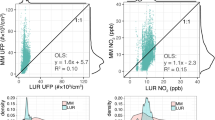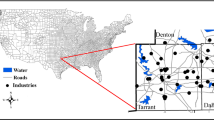Abstract
Pollution exhibits significant variations horizontally and vertically within cities; therefore, the size and three-dimensional (3D) spatial distribution of population are significant determinants of urban health. This paper presents a novel methodology, 3D digital geography (3DIG) methodology, for investigating 3D spatial distributions of population in close proximity to traffic, thus the potential highly exposed population under traffic impacts. 3DIG applies geographic information system and fine-resolution (5 m) digital terrain models to obtain the number of building floors in residential zones of the Taipei metropolis; the vertical distribution of population at different floors was estimated based on demographic data in each census tract. In addition, population within 5, 10, 20, 50, and 100 m from the roadways was estimated. Field validation indicated that model results were reliable and accurate; the final population estimation differs only by 0.88% from the demographic database. The results showed that among the total 6.5 million Taipei residents, 0.8 (12.3%), 1.5 (22.9%), 2.3 (34.9), and 2.7 (41.1%) million residents live on the first or second floor within 5, 10, 20, and 50 m, respectively, of municipal roads. There are 22 census tracts with more than half of their residents living on the first or second floor within 5 m of municipal roads. In addition, half of the towns in Taipei city and county with >13.9% and 12.1% of residents live on the first and second floors within 5 m of municipal roads, respectively. These findings highlight the huge number of Taipei residents in close proximity to traffic and have significant implications for exposure assessment and environmental epidemiological studies. This study demonstrates that 3DIG is a versatile methodology for various research and policy planning in which 3D spatial population distribution is the central focus.
This is a preview of subscription content, access via your institution
Access options
Subscribe to this journal
Receive 6 print issues and online access
$259.00 per year
only $43.17 per issue
Buy this article
- Purchase on Springer Link
- Instant access to full article PDF
Prices may be subject to local taxes which are calculated during checkout


Similar content being viewed by others
References
Aguilera I., Sunyer J., Fernadez-Patier R., Hoek G., Aguirre-Alfaro A., and Meliefste K., et al. Estimation of outdoor NOx, NO2, and BTEX exposure in a cohort of pregnant women using land use regression modeling. Enviro Sci Technol 2008: 42: 815–821.
Alagarni D.A., and El hassan I.M. Comparison of thin plate spline, polynomial, C1-function and Sheppard's interpolation techniques with GPS-derived DEM. Int J Appl Earth Obs 2001: 3: 155–161.
Barraza-Villarreal A., Sunyer J., Hernandez-Cadena L., Escamilla-Nuñez M.C., Sienra-Monge J.J., and Ramírez-Aguilar M., et al. Air pollution, airway inflammation, and lung function in a cohort study of Mexico City schoolchildren. Environ. Health Perspect 2008: 116: 832–838.
Bielecka E. A Dasymetric Population Density Map of Poland. Proceedings of the International Cartographic Conference, A Coruña, Spain, 2005.
Brunn A., and Weidner U. Hierarchical Bayesian nets for building extraction using dense digital surface models. ISPRS J Photogramm 1998: 53: 296–307.
Directorate General of Budget (DGB). National Statistics- Current Index 2011a. Available: http://www.stat.gov.tw/point.asp?index=4 (accessed 5 January 2011).
Directorate General of Budget (DGB). National Statistics: 2010 Population and Housing Census 2011b. Available: http://www.moi.gov.tw/index.aspx (accessed 5 January 2011).
Edwards R.D., Jurvelin J., Koistinen K., Saarela K., and Jantunen M. VOC source identification from personal and residential indoor, outdoor and workplace microenvironment samples in EXPOLIS-Helsinki, Finland. Atmos Environ 2001: 35: 4829–4841.
Fann-Jiang W.K. Concentrations of airborne volatile organic compounds around roadside and gasoline stations in Taipei city. M.Sc. Thesis, National Yang Ming University, Taipei, Taiwan 2000 (in Chinese, with English abstract).
Henderson S.B., Beckerman B., Jerrett M., and Brauer M. Application of land use regression to estimate long-term concentrations of traffic-related nitrogen oxides and fine particulate matter. Environ Sci Technol 2007: 41: 2422–2428.
Health Effect Institute (HEI). Health Effects of Traffic-Related Air Pollution: A Critical Review of the Literature on Emissions, Exposure, and Health Effects. Health Effect Institute, Special Report 17, Boston, Massachusetts, 2010.
Hitchins J., Morawska L., Gilbert D., and Jamriska M. Dispersion of particles from vehicle emissions around high and low-rise buildings. Indoor Air 2002: 12: 64–71.
Hoffmann B., Moebus S., Möhlenkamp S., Stang A., Lehmann N., and Dragano N., et al. Residential exposure to traffic is associated with coronary atherosclerosis. Circulation 2007: 116: 489–496.
Ilgen E., Karfich N., Levsen K., Angerer J., Schneider P., and Heinrich J., et al. Aromatic hydrocarbons in the atmospheric environment: Part I. Indoor versus outdoor sources, the influence of traffic. Atmos Environ 2001: 35: 1235–1252.
Jerrett M., Arain A., Kanaroglou P., Beckerman B., Potoglou D., and Sahsuvarogiu T., et al. A review and evaluation of intraurban air pollution exposure models. J Ecpo Anal Environ Epidemiol 2005: 15: 185–204.
Jo W.K., and Lee J.Y. Indoor and outdoor levels of respirable particulates (PM10) and carbon monoxide (CO) in high-rise apartment buildings. Atmos Environ 2006: 40: 6067–6076.
Lung SCC, Mao IF, and Liu LJS Residents particle exposures in six different communities in Taiwan. Sci Total Environ 2007: 377: 81–92.
Lwin K, and Murayama Y A GIS approach to estimation of building population for micro-spatial analysis. Transactions in GIS 2009: 13: 401–414.
McCreanor J, Cullinan P, Nieuwenhuijsen MJ, Stewart-Evans J, Malliarou E, and Jarup L, et al. Respiratory effects of exposure to diesel traffic in persons with asthma. N Engl J Med 2007: 357: 2348–2358.
Miller C, and Laflamme R The digital terrain model – theory and application. Photogramm Engineering 1958: 24: 433–442.
Ministry of Transportation and Communications (MOTC). User guideline of maps of road networks. MOTC, Taipei, Taiwan, 2009.
Ministry of Transportation and Communications (MOTC). Vehicle Statistics 2010. Available: http://www.motc.gov.tw/mocwebGIP/wSite/dp?mp=2 (accessed 13 January 2011).
National Land Surveying and Mapping Center (NLSMC) Land Use Investigation of Taiwan 2009 Available: http://lui.nlsc.gov.tw/LUWeb/eng/AboutLU.aspx (accessed 3 December 2010).
Rules of Architecture Techniques (ROAT) Public Law 161-1 2010 Available: http://glrs.moi.gov.tw/LawContentDetails.aspx (accessed 7 December 7 2010).
Sleeter R. A New Method for Mapping Population Distribution, Washington, DC, US. Geological Survey Fact Sheet 2008–3010 2008 Available: http://pubs.usgs.gov/fs/2008/3010/ (accessed 5 August 2011).
Satellite Survey Center (SSC). Department of Land Administration. High Precision and High Resolution DTM. Available: https://www.gps.moi.gov.tw/satellite/DTM/DTM_03.htm (accessed 3 December 2010).
United Nations (UN). Population Challenges and Development Goals. ST/ESA/SER.A/248 UN, New York, 2005.
United State Geological Survey (USGS). Rocky Mountain Mapping Center 2001 Available: http://rockyweb.cr.usgs.gov/elevation/dpi_dem.html (accessed 8 February 2011).
Acknowledgements
We thank Professor Jihn-Fa Jan, Department of Land Economics, National Chengchi University, Taiwan, for his help of DTM data processing and programming. We also acknowledge Computing Center, Academia Sinica, Taiwan, for providing GIS data.
Author information
Authors and Affiliations
Corresponding author
Ethics declarations
Competing interests
The authors declare no conflict of interest.
Additional information
Supplementary Information accompanies the paper on the Journal of Exposure Science and Environmental Epidemiology website
Supplementary information
Rights and permissions
About this article
Cite this article
Wu, CD., Lung, SC. Applying GIS and fine-resolution digital terrain models to assess three-dimensional population distribution under traffic impacts. J Expo Sci Environ Epidemiol 22, 126–134 (2012). https://doi.org/10.1038/jes.2011.48
Received:
Accepted:
Published:
Issue Date:
DOI: https://doi.org/10.1038/jes.2011.48
Keywords
This article is cited by
-
Vertical variation of source-apportioned PM2.5 and selected volatile organic compounds near an elevated expressway in an urban area
Environmental Science and Pollution Research (2024)
-
Vertical distribution of source apportioned PM2.5 using particulate-bound elements and polycyclic aromatic hydrocarbons in an urban area
Journal of Exposure Science & Environmental Epidemiology (2020)
-
Mapping the vertical distribution of population and particulate air pollution in a near-highway urban neighborhood: Implications for exposure assessment
Journal of Exposure Science & Environmental Epidemiology (2014)



